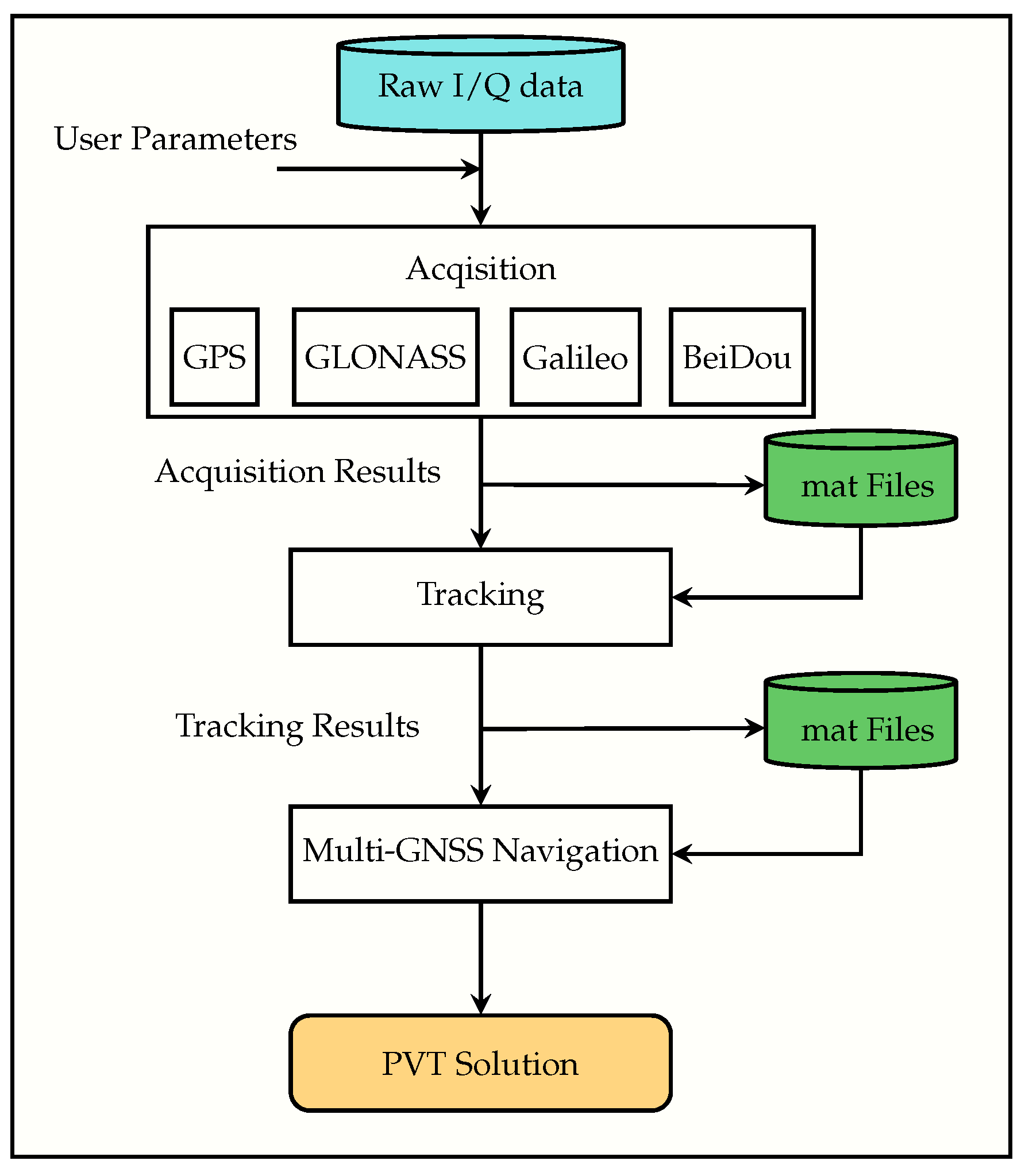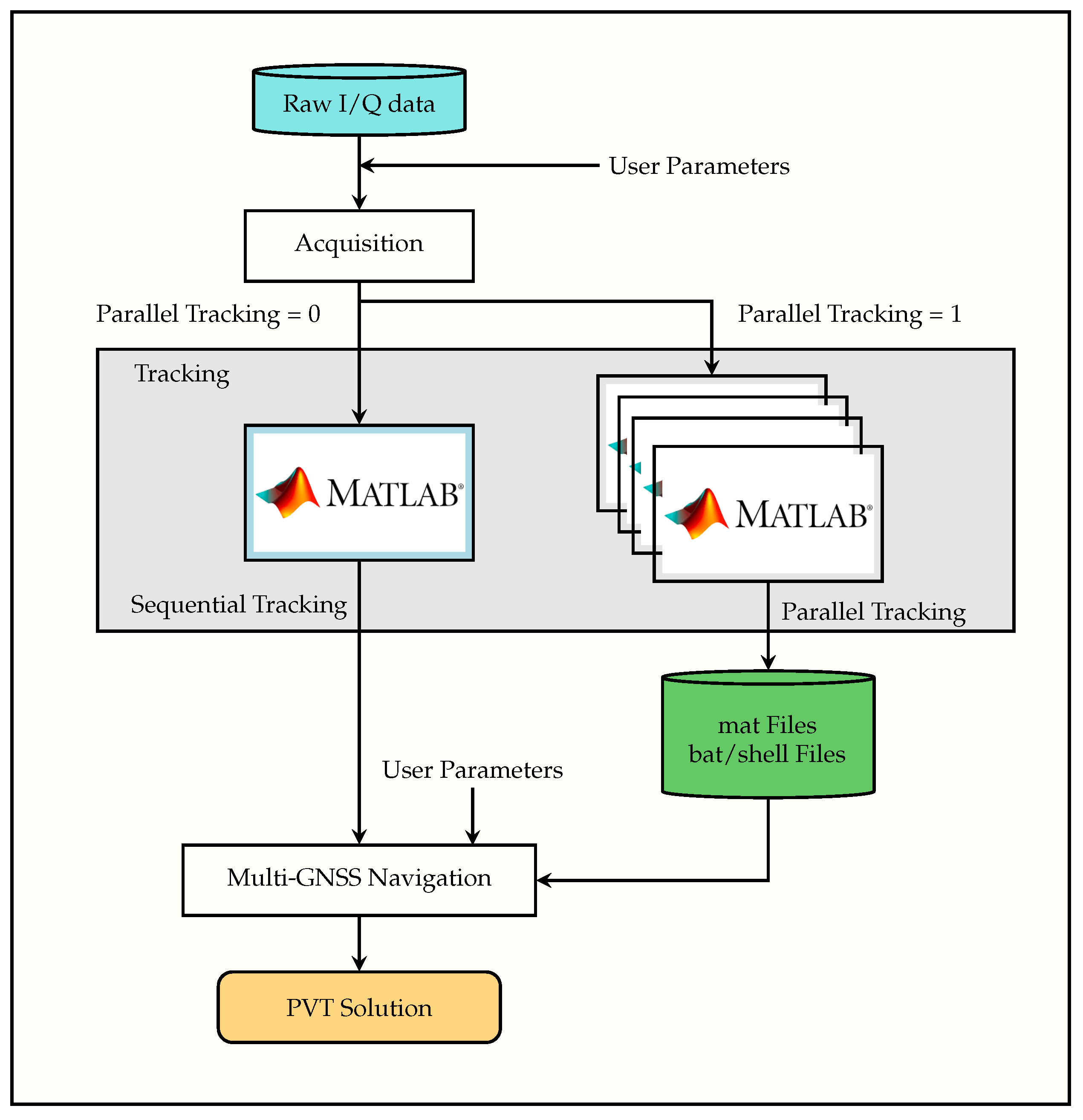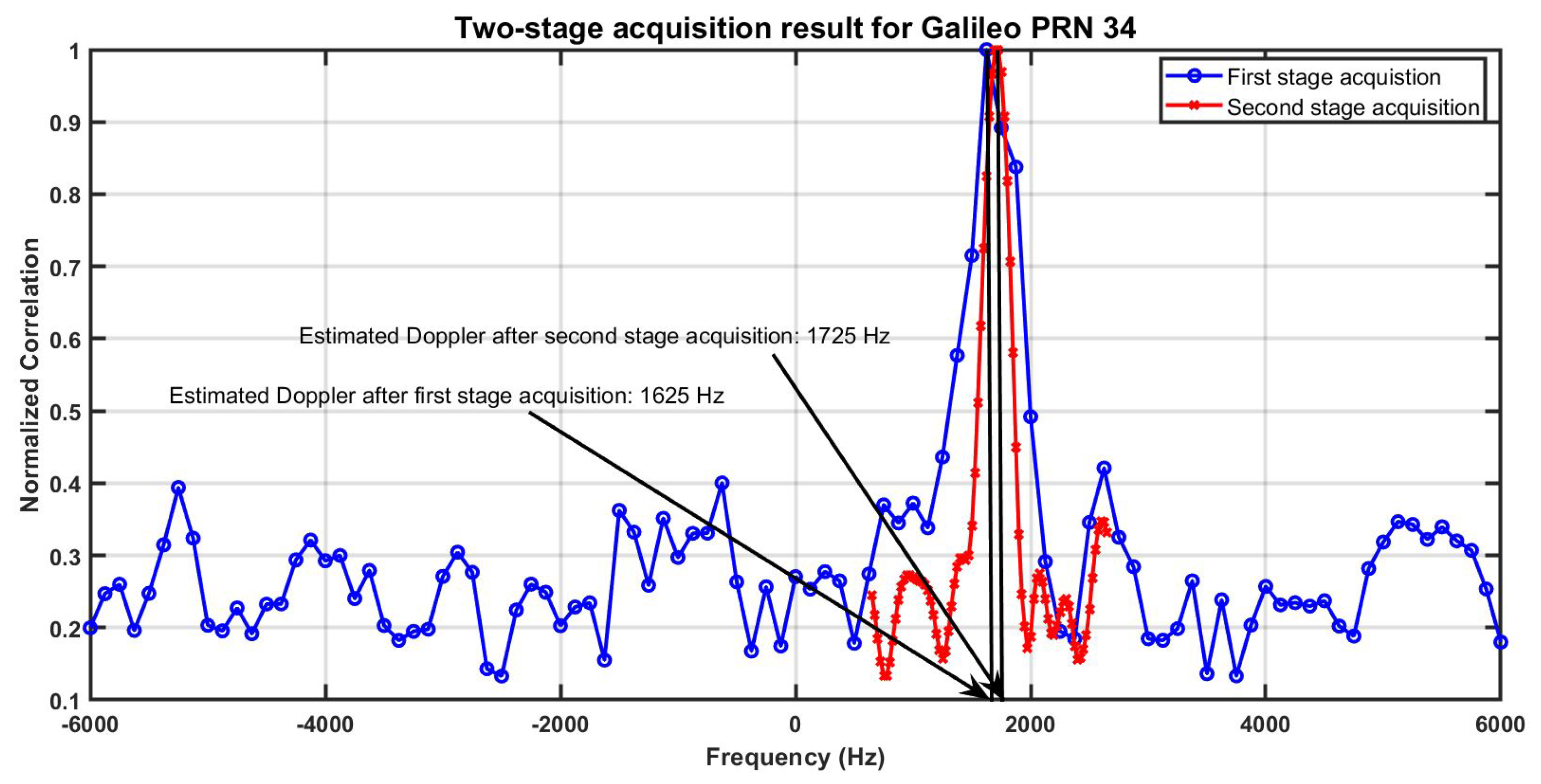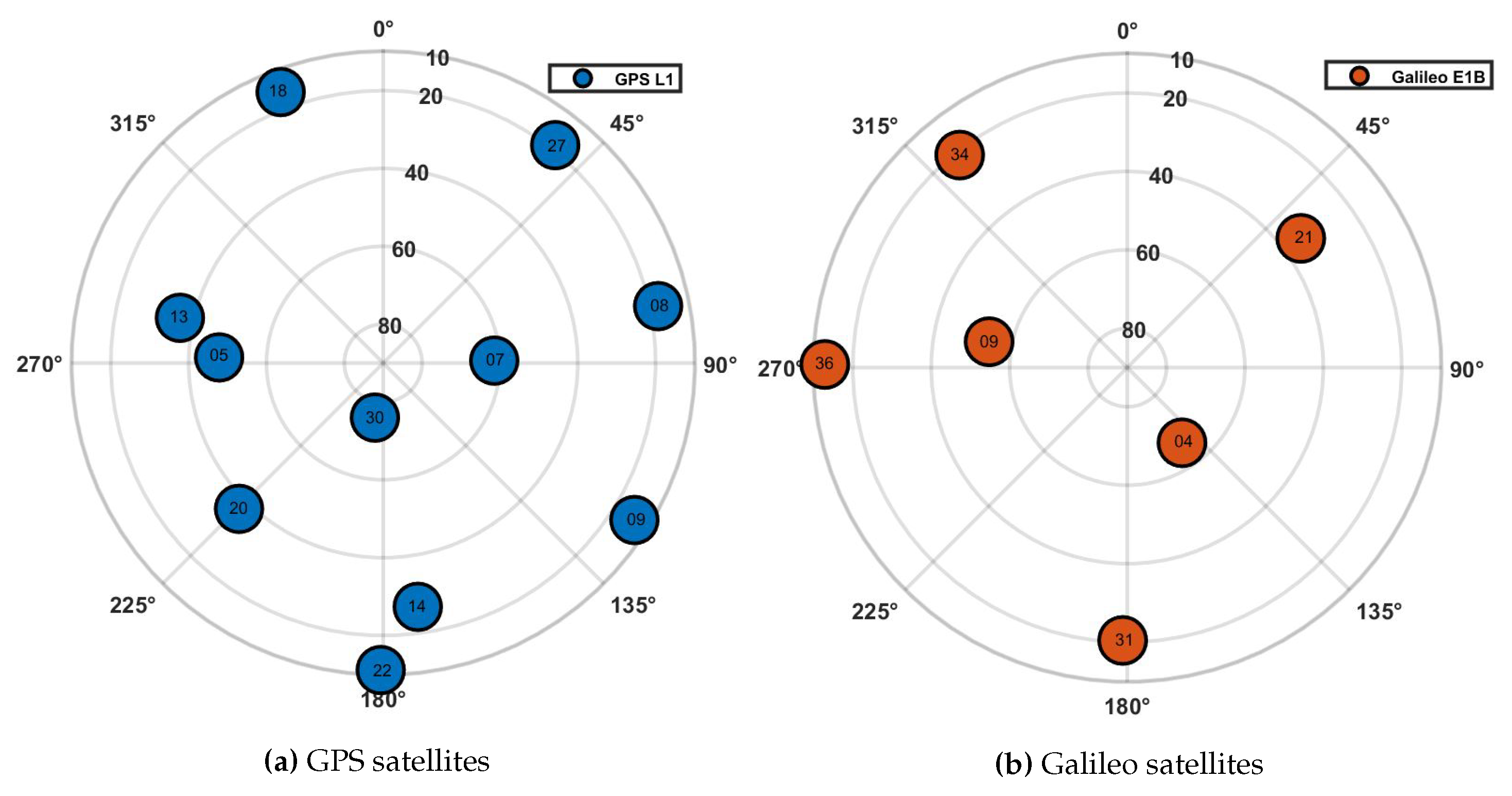Submitted:
07 May 2024
Posted:
08 May 2024
You are already at the latest version
Abstract
Keywords:
1. Introduction
2. FGI-GSRx Software-Define Receiver
2.1. Existing Sequential Receiver Architecture
2.2. Limitations of FGI-GSRx-v1.0.0
3. FGI-GSRx-v2.0.0: Design and Architecture
3.1. Design Strategies for Software-Defined GNSS Receivers
- Code Profiling: This refers to identifying performance bottlenecks through code profiling and optimizing critical sections of the code base. This may involve restructuring algorithms, minimizing function call overhead, and optimizing memory access patterns to improve overall processing speed. A significant effort was made in this regard for the development of v2.0.0 that included identifying the functions and processes contributing maximum processing time and removing redundant variables and computations. This effort lead to improved tracking time via v2.0.0 sequential mode as compared to v1.0.0. A more detailed insight is presented in Section 5.1 and Section 5.2.
- Memory Management and Parallelization: Parallel processing techniques and efficient memory management of the processing unit can lead to minimize memory access latency and improve overall processing speed. FGI-GSRx-v2.0.0 parallel processing mode is aimed at distributing computational tasks by invoking multiple MATLAB instances so as to utilize the maximum processing power of the processing units, such as CPU cores. This can significantly speed up signal processing algorithms, especially those that are inherently parallelizable, such as correlation and FFT (Fast Fourier Transform) operations. An analysis on performance of memory management using various versions of FGI-GSRx is shown in Section 5.3.
3.2. FGI-GSRx-v2.0.0 Receiver Architecture
- Acquisition: The acquisition block searches and acquires satellite signals one at a time. The signals are handed over to the tracking block once the search is complete. v2.0.0 also supports multiple GNSS constellations as v1.0.0. The acquisition data contains the information regarding each signal acquired (observations, duration, signal, channel) as well as statistics from the acquisition phase (e.g., peak Metric, peak value, variance, baseline, standard deviation, code phase, carrier frequency and satellite ID).
-
Tracking: The tracking block utilizes the acquisition data and correlates the incoming signal with signal replicas to generate tracking measurements from all signals and satellites. In v1.0.0, the signal tracking of each satellite is processed sequentially which was not very effective especially for the processing of longer datasets leading to higher processing time. To overcome this limitation, in v2.0.0, the user can conveniently choose between two possible options to execute the tracking process. These include:
- -
- Sequential Tracking Mode: This mode is developed on the similar lines as v1.0.0. However, v2.0.0 offers an improved sequential tracking architecture, which is carried out by code profiling, efficient handling of data variables, identifying and optimizing high complexity and time consuming processes that ultimately contributed to faster data processing.
- -
- Parallel Tracking Mode: Parallel tracking mode is aimed at maximizing the CPU utilization to speed up the processing. The parallel processing is done at the signal tracking stage only, since this is the most computationally extensive part of the receiver. The idea is to initiate multiple parallel instances of MATLAB for processing each satellite individually to achieve maximum CPU utilization from the processing platform. In this particular case, the operating system takes care of running multiple instances by allocating enough resources for these demanding parallel instances. For example, if there are altogether 17 GPS and Galileo satellites available from the acquisition stage, the new receiver architecture will open 17 MATLAB instances where each instance will process one individual tracking channel. The work flow diagram of v2.0.0 parallel tracking block is divided into three main steps as shown in Figure 3.
- Multi-GNSS Navigation: This block offers data decoding of the output generated from the tracking block and converts the processed track data into receiver observables in terms of satellite-specific pseudoranges and ephemeris for each GNSS constellation. The navigation block has four main tasks: to convert the measurements into observations, calculate each satellite’s PVT, apply satellite and environmental corrections, and finally estimate the PVT solution of the user with the corrected pseudoranges.
3.2.1. FGI-GSRx-v2.0.0 Parallel Tracking Mode
3.3. Other Functional Enhancements
4. Assessment and Data Processing Strategy
4.1. Assessment Strategies
4.2. Data Processing Strategy
5. Result Analysis
5.1. Code Profiling
5.2. Data Processing
5.3. Resource Management
5.3.1. Comparison with MATLAB Parallel Processing Toolbox
5.4. Accuracy
6. Conclusions
Author Contributions
Data Availability Statement
Conflicts of Interest
References
- The FGI-GSRx software defined GNSS receiver goes open source. Available online: https://www.maanmitta uslaitos.fi/en/fgi-gsrx-os (accessed on 22 February 2024).
- Pany, T., et. all., GNSS Software-Defined Radio: History, Current Developments, and Standardization Efforts. NAVIGATION: Journal of the Institute of Navigation 2024, 71. [CrossRef]
- Islam, S., Bhuiyan, M. Z. H., Liaquat, M., Pääkkönen, I. and Kaasalainen, S., FGI’s GNSS Spoofing Dataset Repository (FGI-SpoofRepo). National Land Survey of Finland, FGI Dept. of Navigation and positioning, (2024). [CrossRef]
- Gamba, M. T., Truong, M. D., Motella, B., Falletti, E. and Ta, T. H., Hypothesis testing methods to detect spoofing attacks: a test against the TEXBAT datasets. GPS Solutions 2017, 21, pp.577–589.
- Carles Fernández-Prades., et.all., GNSS-SDR: An open source tool for researchers and developers, In the Proceedings of 24th Int. Tech. Meeting Sat. Div. Inst. Navig., (Portland, OR), (2011), pp. 780–794.
- Sun, K., Presti and L. Lo., A Two Steps GNSS Acquisition Algorithm, in Proceedings of the 22nd International Technical Meeting of the Satellite Division of The Institute of Navigation (ION GNSS 2009), Savannah, GA, September 2009, pp. 3156-3164.
- Fernández-Prades, C., Vilà-Valls, J., Arribas J. and Ramos, A., Continuous Reproducibility in GNSS Signal Processing. IEEE Access 2018, 6, pp.20451-20463.
- Islam, S., Bhuiyan, M. Z. H., Thombre and S., Kaasalainen, S., Combating Single-Frequency Jamming through a Multi-Frequency, Multi-Constellation Software Receiver: A Case Study for Maritime Navigation in the Gulf of Finland. Sensors, 2022, 22 (6), 2294.
- Cristodaro, C., Dovis, F., Falco, G. and Pini, M., GNSS receiver performance in urban environment: Challenges and test approaches for automotive applications, In the Proceedings of International Conference of Electrical and Electronic Technologies for Automotive, Turin, Italy, (2017), pp. 1-6.
- Luo, Q., Cao, Y., Liu, J. and Benslimane, A., Localization and navigation in autonomous driving: Threats and countermeasures, IEEE Wireless Commun. 2019, 26(4), pp. 38-45.
- Rodriguez, R., Jenkins, D. M., Leary, J. J. K., Nolan, K. M. and Mahnken, B. V., Performance analysis of GNSS units in manned helicopter operations, IEEE Aerosp. Electron. Syst. Mag. 2018, 33(10), pp. 14-20.
- Zavorotny, V. U. , Gleason, S., Cardellach, E. and Camps, A., Tutorial on remote sensing using GNSS bistatic radar of opportunity", IEEE Geosci. Remote Sens. Mag. 2014, 2(4), pp. 48-48.
- Neil, J., Cosart, L. and Zampetti, G., Precise timing for vehicle navigation in the smart city: An overview, IEEE Commun. Mag. 2020, 58(4), pp. 54-59.
- GNSS User technology report. Available online: https://prod5.assets-cdn.io/event/6041/assets/8361034923-231960e68d.pdf (accessed on 21 February 2024).
- GNSS Chip market by devices,application, vertical and geograpgy- Global forcast to 2022. Available online: https://www.marketsandmarkets.com/Market-Reports/gnss-chip-market-188819977.html (accessed on 21 February 2024).
- Zangenehnejad, F. and Gao, Y. GNSS smartphones positioning: advances, challenges, opportunities, and future perspectives, Satellite Navigation 2021, 2.
- D. M. Akos, A software radio approach to global navigation satellite system receiver design. Ohio University, 1997.
- Akos, D. M., Stockmaster, M., Tsui, J. B. and Caschera, J. Direct bandpass sampling of multiple distinct RF signals. IEEE Transactions on Communications, 1999, 47(7), 983–988.
- Akos, D. M., Normark, P.-L., Enge, P., Hanssona A. and Rosenlind, A., Real-time GPS software radio receiver, In the Proceedings of the 2001 National Technical Meeting of the Institute of Navigation, Long Beach, CA, (2001), 809–816.
- Ledvina, B., Powell, S., Kintner, P. and Psiaki, M., A 12-channel real-time GPS L1 software receiver1, In the Proceedings of the 2003 National Technical Meeting of the Institute of Navigation, Anaheim, CA, (2003), 767–782.
- Ledvina, B., Psiaki, M., Humphreys, T., Powell, S. and Kintner, P., A real-time software receiver for the GPS and Galileo L1 signals, In the Proceedings of the 19th International Technical Meeting of the Satellite Division of the Institute of Navigation (ION GNSS 2006), Fort Worth, TX, 2321–2333.
- Engel, F., Mumford, P., Parkinson, K., Rizos, C. and Heiser, G., An open GNSS receiver platform architecture, Journal of Global Positioning Systems 2004, 3, pp. 63–69.
- Paakki, T., Raasakka, J., Della Rosa, F., Hurskainen, H. and Nurmi, J., TUTGNSS University based hardware/software GNSS receiver for research purposes, in Ubiquitous Positioning Indoor Navigation and Location Based Service, (2010), pp. 1–6.
- Pany, T., Dötterböck, D., Gomez-Martinez, H., Hammed, M. S., Hörkner, F., Kraus, T., Maier, D., Sanchez-Morales, D., Schütz, A., Klima, P. and Ebert, D., The multi-sensor navigation analysis tool (MuSNAT) – Architecture, LiDAR, GPU/CPU GNSS signal processing, In the Proceedings of the 32nd International Technical Meeting of the Satellite Division of the Institute of Navigation (ION GNSS+ 2019), Miami, FL, 4087–4115.
- Borre, K., Akos, D. M., Bertelsen, N., Rinder, P. and Jensen, S. H., A Software-Defined GPS and Galileo Receiver, a single frequency approach. Birkhauser, (2007).
- Li, Y., Shivaramaiah, N. C. and Akos, D. M., Design and implementation of an open-source BDS-3 B1C/B2a SDR receiver, GPS Solutions 2019 23, pp. 60.
- Gunawardena, S., A high performance easily configurable satnav SDR for advanced algorithm development and rapid capability deployment, In the proceedings of the 2021 International Technical Meeting of the Institute of Navigation, (2021), 539–554.
- Gunawardena, S., Pany, T. and Curran, J., ION GNSS software-defined radio metadata standard. NAVIGATION 2021, 68(1), 11–20.
- softGNSS. Available online: https://github.com/TMBOC/SoftGNSS (accessed on 16 April 2024).
- Kassas, Z., Bhatti, J. and Humphreys, T., A graphical approach to GPS software-defined receiver implementation, In the Proceedings of the 2013 IEEE Global Conference on Signal and Information Processing, Austin, TX, (2013), 1226–1229.
- Kassas, Z., Kozhaya, S., Saroufim, J., Kanj, H. and Hayek, S. A look at the stars: Navigation with multi-constellation LEO satellite signals of opportunity. Inside GNSS Magazine 2023, 18(4), 38–47.
- Kassas, Z., Neinavaie, M., Khalife, J., Khairallah, N., Haidar-Ahmad, J., Kozhaya and S., Shadram, Z., Enter LEO on the GNSS stage: Navigation with Starlink satellites, Inside GNSS 2021, 16(6), 42–51.
- López-Salcedo, J. A., Capelle, Y., Toledo, M., Seco, G., López-Vicario, J., Kubrak, D., Monnerat, M., Mark, A. and Jiménez, D., DINGPOS: A hybrid indoor navigation platform for GPS and Galileo In the Proceedings of the International Technical Meeting of the Satellite Division of the Institute of Navigation (ION GNSS 2008), Savannah, GA, 1780–1791.
- López-Salcedo, J. A., Parro-Jiménez, J. M. and Seco-Granados, G., Multipath detection metrics and attenuation analysis using a GPS snapshot receiver in harsh environments In the Proceedings of the 2009 3rd European Conference on Antennas and Propagation (EuCAP), Berlin, Germany, (2009), 3692–3696.
- T.Takasu., RTKLIB: open-source Program Package for RTK-GPS, FOSS4G, Tokyo, Japan, (2009).
- Takasu, T. and Yasuda, A., Development of the low-cost RTK-GPS receiver with an open source program package RTKLIB. In the Proceedings of the International Symposium on GPS/GNSS, Seogwipo-si, Republic of Korea,(2009); volume 1, Pp. 1-6.
- GALILEO Open Service Navigation Message Authentication (OSNMA) Info Note. Available online: https://www.gsc-europa.eu/sites/default/files/sites/all/files/Galileo_OSNMA_Info_Note.pdf (accessed on 17 January 2024).
- Hernández, I.F., Ashur, T., Rijmen, V., Sarto, C., Cancela, S. and Calle, D., Toward an Operational Navigation Message Authentication Service: Proposal and Justification of Additional OSNMA Protocol Features. In In Proceedings of the European Navigation Conference (ENC), (2019), Pp. 1-6.
- Hernández, I.F., Giovanni V., Díaz-Pulido, F., Galileo Authentication: A Programme and Policy Perspective, In Proceedings of the 69th International Astronautical Congress, Bremen, Germany. (2018), Pp. 1-5..
- Lesjak, R., Schweitzer, S., Vallet García, J. M., Diengsleder-Lambauer, K. and Solmaz, S., A Comparative Experimental Performance Assessment of RTK+OSNMA-Based Positioning for Road Vehicle Applications. Eng. Proc., 2023, 54, 45.
- Vallet García, J.M.; Bhuiyan, M.Z.H. RTK+OSNMA Positioning for Road Applications: An Experimental Performance Analysis in Finland, Sensors, 2024, 24, 621.
- Hammarberg, T., García, J. M. V., Alanko, J. N., and Bhuiyan, M. Z. H., An Open Source Implementation of Galileo’s Open Service Navigation Message Authentication, In Proceedings of the 36th International Technical Meeting of the Satellite Division of The Institute of Navigation (ION GNSS+ 2023), Denver, Colorado, (2023), Pp. 3774-3785.
- Hammarberg, T., García, J. M. V., Alanko, J. N., Bhuiyan, M. Z. H., An Experimental Performance Assessment of Galileo OSNMA. Sensors, 2024, 24, 2, 404.
- Liaquat, M., Bhuiyan, M. Z. H., Hammarberg T., Islam, S. and Kaasalainen S., An End to End Solution Towards Navigation Message Authentication Utilizing Open Source FGI-GSRx and FGI-OSNMA. accepted in European Navigation Conference 2024).
- Fernandez-Prades, C. , Arribas, J. and Closas, P., Assessment of software-defined gnss receivers, in 8th ESA Workshop on Satellite Navigation Technologies and European Workshop on GNSS Signals and Signal Processing (NAVITEC), Noordwijk, Netherlands, (2016), pp. 1-9.
- Grenier, A., Lohan, E. S., Ometov, A. and Nurmi, J., An Open-Source Software-Defined Receiver for GNSS Algorithms Benchmarking, In the Proceedings of 14th International Congress on Ultra Modern Telecommunications and Control Systems and Workshops (ICUMT), Valencia, Spain, (2022), pp. 31-38.
- Kai, B., Ignacio, F.H., Jose A., L.S. and Bhuiyan, M. Z. H. (2022)., GNSS Software Receivers. Cambridge University Press.
- Söderholm, S., Bhuiyan, M., Thombre, S., Ruotsalainen, L. and Kuusniemi, H. A multiGNSS software-defined receiver: Design, implementation, and performance benefits, Annals of Telecommunications 2016, 71, pp. 399–410.
- Bhuiyan, M. Z. H., Söderholm, S., Thombre, S., Ruotsalainen, L. and Kuusniemi, H. Overcoming the challenges of BeiDou receiver implementation, Sensors 2014, 14(11), 22082–22098.
- Thombre, S., Bhuiyan, M. Z. H., Söderholm, S., Kirkko-Jaakkola, M., Ruotsalainen and L., Kuusniemi, H., A software multi-GNSS receiver implementation for the Indian regional navigation satellite system, IETE Journal of Research 2016, 62(2), 246–256.
- Borre K., Fernández-Hernández I., López-Salcedo J. A., Bhuiyan M. Z. H., eds., GLONASS L1OF Receiver Processing. In: GNSS Software Receivers. Cambridge University Press; 2022:126-139.
- Ferrara, N. G., Bhuiyan, M. Z. H., Söderholm, S., Ruotsalainen, L. and Kuusniemi, H., A new implementation of narrowband interference detection, characterization, and mitigation technique for a software-defined multi-GNSS receiver, GPS Solutions 2010, 22, 1–15.
- Linty, N., Bhuiyan, M. Z. H. and Kirkko-Jaakkola, M., Opportunities and challenges of Galileo E5 wideband real signals processing. In the Proceedings of International Conference on Localization and GNSS (ICL-GNSS), (2020), Pp 1–6.
- Borre, K., Fernández-Hernández, I., López-Salcedo, J. A. and Bhuiyan, M. Z. H., eds., GNSS Signals and Receivers. In: GNSS Software Receivers. Cambridge University Press; 2022:1-107.
- Borre K., Fernández-Hernández I., López-Salcedo J. A. and Bhuiyan M. Z. H., eds., Galileo E1 Receiver Processing. In: GNSS Software Receivers. Cambridge University Press; 2022:140-152.
- International GNSS service. Available online: https://igs.org (accessed on 02 April 2024).
- FGI-GSRx Release notes. Available online: https://github.com/nlsfi/FGI-GSRx/releases/tag/FGI-GSRx-v2.0.0 (accessed on 02 April 2024).
- FGI OSNMA datasets. [CrossRef]










| Feature | Solution | Remark |
|---|---|---|
| Operating system | Windows10, LINUX | Supports any operating system that can host MATLAB or OCTAVE. |
| Programming environment | MATLAB | MATLAB 2019 or later versions and OCTAVE. |
| Input source | Raw I/Q data | Digitized raw I/Q samples after analog to digital conversion |
| Processing mode | Post-processing | Can process raw I/Q data or load previously processed and saved acquisition or tracking MATLAB data files. |
| Supported GNSS | GPS L1, Galileo E1B, BeiDou B1, GLONASS L1, NavIC L5 | Listed signals are for open-source only. In house version of FGI-GSRx can process additional signals. |
| Acquisition | FFT-based signal acquisition | The receiver searches for all the listed satellites defined by the user in the configuration file. |
| Tracking | Three stage tracking | i) Pull in ii) Coarse tracking iii) Fine tracking. |
| Navigation | Least Square Estimation (LSE) -based position computation | Possibility to select satellites based on Carrier-to-Noise density ratio () and elevation cut-off mask. |
| KPI | Remarks |
|---|---|
| Portability | It refers to the usability of the same software in different environments. Both versions can be executed on any platform supporting MATLAB e.g., LINUX and Windows). |
| Openness | This refers to the degree to which something is accessible to view, modify and use. The source codes of both versions of FGI-GSRx are publicly available and can be modified as per user requirement [1]. |
| Interoperability | This refers to the possibility to exchange information with other free and proprietary software, devices, sensors or systems. For example, the ongoing work in [44] is a good example of integration of FGI-GSRx with FGI-OSNMA. |
| Reproductibility | It describes the capacity of a whole process to be replicated either by own team or some external research group. Both versions of FGI-GSRx support this KPI and have been tested thoroughly by in-house research team while v1.0.0 has also been tested by researchers [3,8,48,49]. |
| Usability | This KPI is concerned with the availability of a (versioned) user manual, tutorials, detailed procedures. In this context, both versions are supported by datasets, release notes and user manuals which are available for download from the online repository [57]. |
| Efficiency | It refers to optimizing the speed and memory requirements or power consumption by the processor running the SDR. FGI-GSRx-v2.0.0 offers better efficiency as compared to v1.0.0. More insight into this functionality is presented in Section 5.2 and Section 5.3. |
| Accuracy | Both versions offers similar code functionalities at the navigation level. However, the minor difference in positioning accuracy can be contributed to the fewer satellites processed by v1.0.0 than v2.0.0 for the given dataset in Section 5.1 and Section 5.4. |
| Processing unit | ||
|---|---|---|
| Processor | i7-12700Hx20 | |
| RAM | 32 GB | |
| Operating System | 64 bit Ubuntu 20.04.6 LTS | |
| Reference dataset | ||
|---|---|---|
| Date | 31.10.2023 | |
| Time | ≈12:23 (UTC) | |
| Duration | 460 s | |
| Size | ≈11.4 GB | |
| Location | FGI rooftop, Espoo | |
| Receiver dynamics | Static | |
| Antenna | Septentrio’s PolaNt Choke Ring | |
| GNSS front-end | NSL Stereo dual band | |
| Signal configurations | ||
|---|---|---|
| Center frequency | 1569 MHz | |
| Bandwidth | 4.2 MHz | |
| Sampling frequency | 26 MHz | |
| Quantization | 8 bits | |
| I/Q | Complex | |
| GNSS constellations | GPS | Galileo |
| Acquisition | ||
| Visible Satellites | PRN 5, 7, 8, 9, 13, 14, 18, 20, 22, 27, 30 | PRN 4, 9, 21, 31, 34, 36 |
| Replica modulation | BPSK | CBOC |
| Max. search freq. | 7000 Hz | 6000 Hz |
| Coherent Integration | 5 ms | 4 ms |
| Non-coherent Integration number | 5 | 3 |
| Threshold | 9 | 9 |
| Tracking | ||
| DLL | ||
| Discriminator | NNEML | NNEML |
| Correlator Spacing | 0.1 | 0.1 |
| Damping ratio | 0.7 | 0.7 |
| Noise bandwidth | 1 | 1 |
| FLL | ||
| Discriminator | atan | atan2 |
| Wide bandwidth (Hz) | 100 | 75 |
| Narrow bandwidth (Hz) | 50 | 45 |
| Very-narrow bandwidth (Hz) | 10 | 5 |
| Damping ratio | 1.8 | 1.5 |
| Loop gain | 0.7 | 0.7 |
| PLL | ||
| Wide bandwidth | 15 | 15 |
| Narrow bandwidth | 15 | 15 |
| Very-narrow bandwidth | 10 | 10 |
| Damping ratio | 0.5 | 0.7 |
| Loop gain | 0.2 | 0.2 |
| Function Name | Function Description | Run Time (v1.0.0) (hh:mm:ss) |
Run Time (v2.0.0) (hh:mm:ss) |
Improvement (%) |
|---|---|---|---|---|
| ’gsrx’ | Main function to execute the whole process chain of FGI-GSRx. |
14:00:10 | 08:24:14 | 40 |
| ’doTracking’ | Main tracking function to do code and carrier tracking. |
13:56:20 | 08:19:00 | 40 |
| ’GNSSTracking’ | Performs state-based tracking for the received signal. |
06:25:10 | 03:16:21 | 49 |
| ’GNSSCorrelation’ | Performs code and carrier correlation. | 07:26:33 | 04:46:12 | 36 |
| ’carrierMixing’ | Performs carrier and code mixing. | 04:09:03 | 01:53:03 | 55 |
| ’CN0fromSNR’ | Function for estimating CN0 values using SNR. |
01:31:05 | 01:07:56 | 25 |
| ’phaseFreqFilter’ | Loop filter to do carrier tracking. | 01:06:12 | 00:44:41 | 32 |
| ’getDataForCorrelation’ | Read data for processing. | 00:51:16 | 00:29:25 | 43 |
| Function | FGI-GSRx-v1.0.0 | FGI-GSRx-v2.0.0 Sequential | FGI-GSRx-v2.0.0 Parallel | ||
|---|---|---|---|---|---|
|
Processing Time (hh:mm:ss) |
Processing Time (hh:mm:ss) |
Improvement (%) |
Processing Time (hh:mm:ss) |
Improvement (%) |
|
| Acquisition | 00:02:09 | 00:02:14 | -1.8 | 00:02:14 | -1.9 |
| Tracking | 13:56:20 | 08:19:00 | 40.31 | 05:42:44 | 59.2 |
| Navigation | 00:01:40 | 00:02:00 | -16.6 | 00:02:00 | -16.6 |
| Total Run Time | 14:00:10 | 08:24:14 | 39.98 | 05:47:53 | 59.13 |
| Constellation | No. of Satellites | FGI-GSRx-v2.0.0 Parallel | FGI-GSRx-v2.0.0 with MATLAB PCT | |||
|---|---|---|---|---|---|---|
|
Processing Time (hh:mm:ss) |
CPU Average (%) |
Processing Time (hh:mm:ss) |
CPU Average (%) |
Improvement w.r.t v2.0.0 Parallel (%) |
||
| Galileo only | 6 | 00:37:56 | 69 | 00:37:48 | 38 | 0.35 |
| GPS only | 11 | 04:07:25 | 90 | 02:51:24 | 58 | 30 |
| GPS + Galileo | 17 | 05:42:44 | 89 | 03:14:36 | 60 | 43 |
| FGI-GSRx-v1.0.0 | FGI-GSRx-v2.0.0 | |
|---|---|---|
| Available Satellites for Position Solution | ||
| GPS | 10 Ephemeris for GPS PRN 27 is not found. |
11 |
| Galileo | 5 Ephemeris for Galileo PRN 21 is not found. |
6 |
| Horizontal Position | ||
| Error50 | 1.74 | 1.62 |
| Error95 | 3.06 | 2.65 |
| Max | 4.39 | 3.83 |
| Std. Dev. | 0.76 | 0.62 |
| RMS | 2.09 | 1.95 |
| Mean | 1.76 | 1.62 |
| Vertical Position | ||
| Error50 | 1.04 | 1.11 |
| Error95 | 3.19 | 3.19 |
| Max | 4.7 | 4.65 |
| Std. Dev. | 0.98 | 0.99 |
| RMS | 1.37 | 1.39 |
| Mean | 1.25 | 1.32 |
| DOP | ||
| Pdop | 1.20 | 1.13 |
| 3DRMS | 2.49 | 2.40 |
| No. of Positioning Epochs | 451 | 451 |
Disclaimer/Publisher’s Note: The statements, opinions and data contained in all publications are solely those of the individual author(s) and contributor(s) and not of MDPI and/or the editor(s). MDPI and/or the editor(s) disclaim responsibility for any injury to people or property resulting from any ideas, methods, instructions or products referred to in the content. |
© 2024 by the authors. Licensee MDPI, Basel, Switzerland. This article is an open access article distributed under the terms and conditions of the Creative Commons Attribution (CC BY) license (http://creativecommons.org/licenses/by/4.0/).





